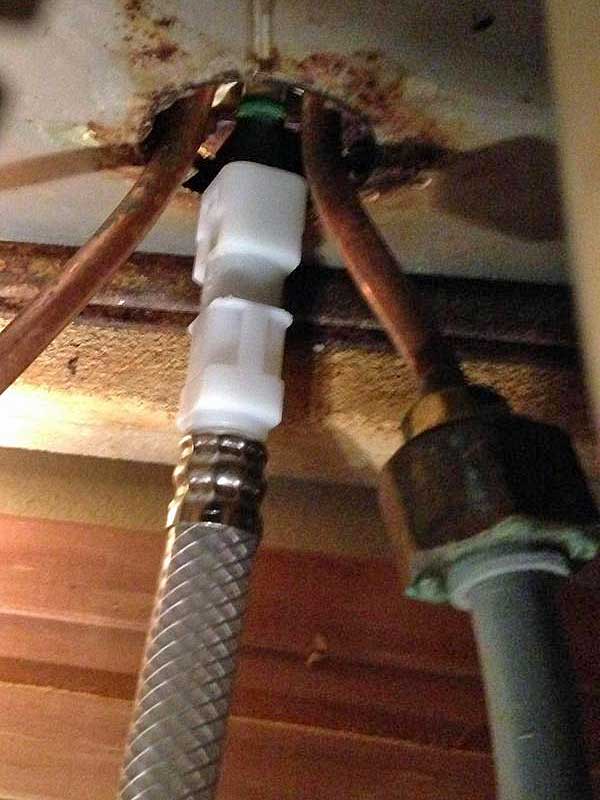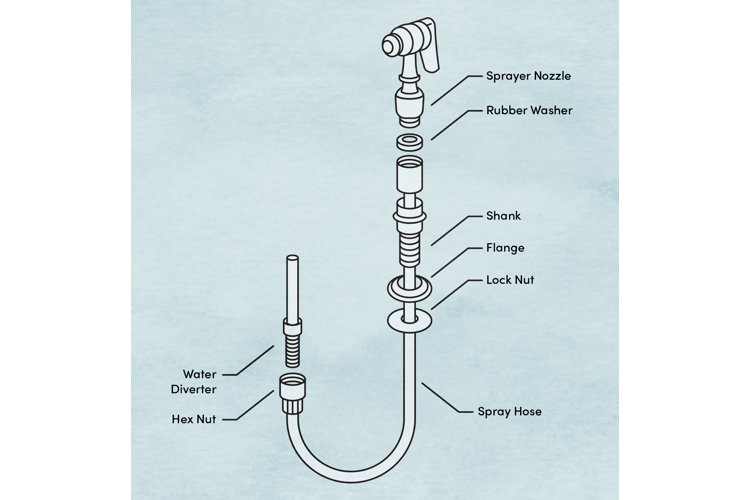How to Fix a Kitchen Sink Sprayer That Loses Pressure
Are you struggling with a kitchen sink sprayer that seems to have lost its pressure? This can be a frustrating problem, especially if you rely on your sprayer for daily tasks such as washing dishes or filling pots with water. Fortunately, there are a few simple steps you can take to fix the issue and get your kitchen sink sprayer back to its full pressure.
How to Troubleshoot Low Water Pressure in a Kitchen Sink Sprayer
Before you start trying to fix the problem, it's important to understand what could be causing the low water pressure in your kitchen sink sprayer. Some common causes include a clogged sprayer nozzle, a faulty hose, or an issue with the water supply. The first step is to identify the root cause so you can find the best solution.
Common Causes of Low Water Pressure in a Kitchen Sink Sprayer
If your kitchen sink sprayer is experiencing low water pressure, there are a few potential reasons why. One of the most common causes is a clogged sprayer nozzle. This can happen over time as sediment and debris build up in the nozzle. Another possible cause is a faulty hose that is kinked or damaged. Lastly, there may be an issue with the water supply, such as a clogged pipe or low water pressure from the main line.
How to Clean a Clogged Kitchen Sink Sprayer Nozzle
If you've determined that a clogged sprayer nozzle is the cause of your low water pressure, the first step is to clean it. This can be done easily with some basic household items. Start by removing the sprayer head from the hose and soaking it in a mixture of warm water and vinegar for about 30 minutes. Then, use a small brush or toothpick to gently remove any debris from the nozzle. Rinse it thoroughly and reattach it to the hose.
Replacing a Kitchen Sink Sprayer Head
If cleaning the sprayer nozzle doesn't solve the problem, you may need to replace the entire sprayer head. This is a simple process and can be done with a few basic tools. Start by turning off the water supply to the sink. Then, use pliers to loosen and remove the old sprayer head. Install the new sprayer head and tighten it with the pliers. Finally, turn the water supply back on and test the sprayer to see if the pressure has improved.
How to Adjust the Water Pressure on a Kitchen Sink Sprayer
If the water pressure in your kitchen sink sprayer is too high, it can also cause problems. This can lead to splashing and an uneven flow of water. Luckily, adjusting the water pressure is a simple task. Most kitchen sink sprayers have a pressure control valve located on the sprayer head. Use a screwdriver to loosen or tighten the valve to adjust the water pressure to your desired level.
How to Replace a Kitchen Sink Sprayer Hose
If the hose itself is the issue, you will need to replace it. This can be done by first turning off the water supply and then disconnecting the hose from both the sprayer head and the water supply line. Take the old hose with you to the hardware store to ensure you get the correct replacement. Once you have the new hose, connect it to the sprayer head and water supply line, and turn the water supply back on.
How to Fix a Leaking Kitchen Sink Sprayer
Another common problem with kitchen sink sprayers is leaking. This can be caused by a damaged or worn out O-ring or washer. To fix this issue, you will need to remove the sprayer head and replace the O-ring or washer. These can be found at most hardware stores and are inexpensive to replace.
How to Install a New Kitchen Sink Sprayer
If you have tried all of the above solutions and are still experiencing low water pressure, it may be time to install a new kitchen sink sprayer. This can be done easily with some basic tools and a new sprayer kit. Start by turning off the water supply and removing the old sprayer head and hose. Then, follow the manufacturer's instructions to install the new sprayer head and hose. Finally, turn the water supply back on and test the new sprayer to ensure it is working properly.
How to Unclog a Kitchen Sink Sprayer
If none of the above solutions have solved your low water pressure problem, there may be a clog in the pipes. This can be caused by debris or buildup over time. To unclog the pipes, you can use a plumbing snake or a chemical drain cleaner. If you are not comfortable doing this yourself, it is best to call a professional plumber to ensure the clog is properly removed.
In conclusion, a kitchen sink sprayer that loses pressure can be a frustrating issue, but it is often easily fixable. By following these steps and troubleshooting the problem, you can get your kitchen sink sprayer back to its full pressure and make your daily tasks in the kitchen much more efficient.
Why Your Kitchen Sink Sprayer Might Be Losing Pressure

Possible Causes of Low Pressure
/25089301983_c5145fe85d_o-58418ef15f9b5851e5f392b5.jpg) If you've noticed that your kitchen sink sprayer is no longer functioning at its usual high pressure, there could be a few different reasons why. The most common cause is a build-up of mineral deposits or debris in the sprayer head, which can restrict the flow of water. This can happen over time as the sprayer is constantly exposed to water and can be exacerbated by hard water. Another possible cause is a faulty or malfunctioning sprayer diverter, which is responsible for directing water to the sprayer instead of the faucet. Finally, a leak or blockage in the water supply line leading to the sprayer can also result in decreased pressure.
If you've noticed that your kitchen sink sprayer is no longer functioning at its usual high pressure, there could be a few different reasons why. The most common cause is a build-up of mineral deposits or debris in the sprayer head, which can restrict the flow of water. This can happen over time as the sprayer is constantly exposed to water and can be exacerbated by hard water. Another possible cause is a faulty or malfunctioning sprayer diverter, which is responsible for directing water to the sprayer instead of the faucet. Finally, a leak or blockage in the water supply line leading to the sprayer can also result in decreased pressure.
How to Troubleshoot and Fix the Problem
 Fortunately, there are a few simple steps you can take to troubleshoot and fix the issue of low pressure in your kitchen sink sprayer. First, try cleaning the sprayer head by soaking it in a mixture of equal parts white vinegar and water for about 30 minutes. This will help dissolve any mineral deposits or debris that may be clogging the sprayer. After soaking, rinse the sprayer head with water and reattach it to the sprayer hose. If this doesn't solve the problem, check the sprayer diverter for any damage or wear and tear. If it appears to be damaged, it will need to be replaced. Additionally, check the water supply line for any leaks or blockages and repair or replace it as needed.
Fortunately, there are a few simple steps you can take to troubleshoot and fix the issue of low pressure in your kitchen sink sprayer. First, try cleaning the sprayer head by soaking it in a mixture of equal parts white vinegar and water for about 30 minutes. This will help dissolve any mineral deposits or debris that may be clogging the sprayer. After soaking, rinse the sprayer head with water and reattach it to the sprayer hose. If this doesn't solve the problem, check the sprayer diverter for any damage or wear and tear. If it appears to be damaged, it will need to be replaced. Additionally, check the water supply line for any leaks or blockages and repair or replace it as needed.
Preventing Future Issues
 To prevent your kitchen sink sprayer from losing pressure in the future, there are a few things you can do. First, make sure to clean the sprayer head regularly to prevent any build-up. You can also install a water softener if you have hard water to reduce the amount of mineral deposits in your plumbing system. Additionally, be gentle when using the sprayer and avoid pulling on the hose too hard, as this can damage the sprayer diverter over time. By taking these preventative measures, you can keep your kitchen sink sprayer functioning at its best and avoid any future issues with low pressure.
In summary, if your kitchen sink sprayer is losing pressure, it could be due to mineral build-up, a faulty sprayer diverter, or a leak/blockage in the water supply line. By troubleshooting and taking preventative measures, you can keep your sprayer functioning at its best and avoid any future issues.
To prevent your kitchen sink sprayer from losing pressure in the future, there are a few things you can do. First, make sure to clean the sprayer head regularly to prevent any build-up. You can also install a water softener if you have hard water to reduce the amount of mineral deposits in your plumbing system. Additionally, be gentle when using the sprayer and avoid pulling on the hose too hard, as this can damage the sprayer diverter over time. By taking these preventative measures, you can keep your kitchen sink sprayer functioning at its best and avoid any future issues with low pressure.
In summary, if your kitchen sink sprayer is losing pressure, it could be due to mineral build-up, a faulty sprayer diverter, or a leak/blockage in the water supply line. By troubleshooting and taking preventative measures, you can keep your sprayer functioning at its best and avoid any future issues.





































:max_bytes(150000):strip_icc()/how-to-unclog-a-kitchen-sink-2718799_sketch_FINAL-8c5caa805a69493ab22dfb537c72a1b7.png)

























:max_bytes(150000):strip_icc()/installing-a-kitchen-sink-sprayer-2718817-03-514088ddb922466eb3d4cd73f3aa85f4.jpg)








































